Chapter – 9
Kinesiology, Biomechanics & Sports
In this post, we have given the Important Questions of Class 11 Physical Education Chapter 9 (Kinesiology, Biomechanics & Sports) in English. These Important Questions are useful for the students who are going to appear in class 11 board exams.
| Board | CBSE Board, UP Board, JAC Board, Bihar Board, HBSE Board, UBSE Board, PSEB Board, RBSE Board |
| Textbook | NCERT |
| Class | Class 11 |
| Subject | Physical Education |
| Chapter no. | Chapter 9 |
| Chapter Name | (Kinesiology, Biomechanics & Sports) |
| Category | Class 11 Physical Education Important Questions in English |
| Medium | English |
Very Short Answer Questions (1 Mark)
Q.1 Define the term biomechanics.
Ans. Biomechanics is defined as the systematic study of the mechanics of body joints. According to Wikipedia, “Biomechanics is the study of the structure and function of the biological system of humans
Q.2 What is a lever?
Ans. The lever is a rigid bar that is capable of rotating about a fixed point called the fulcrum.
Q.3 What do you understand by equilibrium?
Ans. Equilibrium is defined as a state of balance or a stable situation, where opposite forces cancel each other out and where no changes are occurring.
Q.4 What are the different types of equilibrium?
Ans. There are two types of equilibrium. Dynamic equilibrium and static equilibrium.
Q.5 What is a force?
Ans. Force can be defined as a push or pull by one body acting upon another. Force is a product of the mass and acceleration of an object or person.
Q.6 What is the center of gravity?
Ans. The Center of gravity is that point in a body or system around which its mass or weight is evenly distributed or balanced and through which the force of gravity acts.
Q.7 Why do we lean forward while climbing up a hill?
Ans. We lean forward while climbing up a hill to keep the center of gravity low to maintain stability.
Q.8 Which type of lever is used while we curl our biceps?
Ans. Class III lever is used while we curl our biceps.
Q.9 Who will have greater stability?
a. Afat person or a thin person of the same height?
b. Agirl standing in a stand-at-ease position or a girl standing on one leg?
Ans.
a. Afat person.
b. Agirl standing in stand at ease position.
Short Answer Questions 3 Marks
Q.1. Explain dynamic equilibrium.
Ans. Dynamic stability is balancing the body during movement. It frequently happens that the line of gravity of an athlete will fall outside the base of support for the movement. For example, in a sprint start, the body weight is ahead of the supporting foot but before the body can fall forward the other foot moves ahead to provide support and the process repeats itself. A man carrying a heavy bucket in his right hand leans towards his left-hand side to maintain equilibrium. While climbing up a hill the climber bend forward so that he does not fall. The equilibrium is maintained by bringing the CG down.
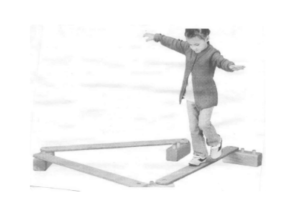
Q.2 What is static equilibrium?
Ans. A body is said to be in stable equilibrium if it comes back to its original position when it is slightly displaced.’Static stability is very important in shooting, archery, handstand in gymnastics, etc. Stable objects generally have wide bases and low CG. The bottom of the ship is made heavy to keep CG as low as possible. This makes the ship stable.

Q3. Give an example of each type of lever which our body uses during various activities.
Ans. The followings are examples of a class I lever which is used by our body. Our skull is the lever arm and the neck muscles at the back of the skull provide the force (effort) to hit the football while we lift our head up against the football (load). When the neck muscles relax, our head nods/hits forward.
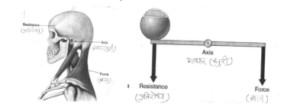
Following is the example of a class II lever which is used by our body. Our calf muscles and Achilles tendon provide the effort when the calf muscle contracts. The load is our body weight and is lifted by effort (muscle contraction).
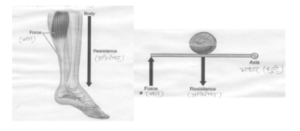
Resistance
Following is the example of a class III lever which is used by our body. The biceps muscle provides the effort (force) and bends the forearm against the weight of the forearm and any weight that the hand might be holding.
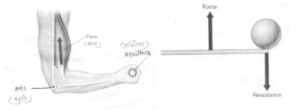
Long Answer Question 5 Marks
Q1. Explain In detail the principle of stability and its uses in sports.
Ans.
(i) Broad base of support: for greater stability increase the area of the base and lower the center of gravity as much as is consistent with the activity involved. Examples:
- a basketball player stops, spreads his feet wide a shoulder line, and lowers his CG to dodge the opponent.

- Defense position of the player in volleyball.
- The wide stance of a golfer.
- Tackling position of a player in football.
(ii) Stability is directly proportional to the weight of the body the object or a person with heavy weight will have greater stability as compared to a person with less weight. For example, it is difficult to move a heavier person as compared to a less heavy person. On the basis of this principle, wrestling, boxing, judo, etc. are organized according to different age groups.

(iii) Direction of an acting force: to start quickly in one direction, keep them as high as possible and as near as possible to the edge of the base nearest to the direction of intended motion.
Example: In the crouched position in starting a race, the CG is kept high by not bending the knees extremely and by keeping the hips high, also the lean of the body is towards the hands so that the weight rests on the hands. From this position, the movement of hands is raised from the ground; motion starts by reason of the pull of gravity. This pull is added to the force exerted against the starting block by the feet and thus aids in speed.

(iv) When the body is free in the air, if the head and feet move down, the hip moves up and vice versa.
Example:
- This principle is applied in the high jump in the western or valley roll technique at the take of, the head and one foot are thrust up as high as possible. As the head and one leg clear the bar, they are dropped which raises the hips to clear the bar. As the hips are lowered, the opposite leg
is raised to clear the bar. - This is also used in the pole vault, hurdles, jackknife, dive in swimming.

Q2. What do you know about centripetal force and centrifugal force? Explain its application in sports.
Ans. Centripetal force: this is the force that pushes or pulls an object towards the axis of rotation in order to make it follow a curve or circular pathway. When a player swings a bat, he applies centripetal force to make that bat follow the arc of the swing. Centrifugal force: this is the force that pushes or pulls an object outward from the axis of rotation. This force is equal to and opposite of the
centripetal force. The centripetal and centrifugal forces have innumerable applications in sports, Centripetal force is needed by the player to maintain his grip. If the rotational momentum is more, the centrifugal force could cause the player to lose his grip and the bat may go off the hand. These forces act when a runner takes a sharp bend and leans inward to obtain the necessary centripetal force. A cyclist going round the curve leans towards the center of the curve in order to get the necessary centripetal force.
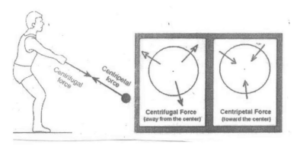
Q.4 Elucidate the importance of biomechanics in sports.
Ans.
- Improves performance in sports: principles of biomechanics tell us about the right techniques, and effective and result-oriented posture to get more efficient results by applying a minimum muscular force which in turn improves performance in sports.
- Improvement in technique: with the help of biomechanical principles the physical education teacher corrects the mistakes. This helps in improving the game and performance of the player.
- Development of improved sports equipment: the principles of biomechanics are used to modify the sports equipment. For example, tee shirts, studs, spikes, swimming costumes, hockey sticks, different size footballs, and low-weight helmets for protection
- Improve the training techniques: a teacher can analyze the player’s movement or action with the help of biomechanical principles. It helps in improving the training techniques.
- Prevents sports injuries: it helps to find out the factors or the forces that can lead to the injuries during the game situation. It also helps in prevention of the sports injury.
- Helps in understanding the human body: it gives the knowledge of different systems of our body. For example, the nervous system, muscular system, and skeletal system.
- Knowledge of safety principles: biomechanics gives the understanding to analyze different movements that can harm the player. The teachers remove those unnecessary and harmful movements.
- Helps in research work: biomechanics helps in the teaching and learning process, it also helps the teacher to acquire precision and accuracy of movement.
- Creates confidence in the player: The player knows that he is executing the movement scientifically with the help of the principle of biomechanics. Thus the confidence of the player is enhanced.
- Helps in maintaining a healthy body: Principals of biomechanics give deep knowledge about the effect of physical forces and movements over the body as well as the movements which are safe and promote health. Thus biomechanics helps in maintaining a healthy body.
- Increases the popularity of sports: biomechanical principles have brought remarkable improvements in respect of technique, equipment, skill, and play fields. It helps in promoting games and sports to the masses.
Q.5 What is the importance of kinesiology in physical education and sports?
Ans.
- By following the principles of kinesiology, the coach can guide he follow contestants to avoid sports injuries while performing.
- Kinesiology helps the sports coach to get better results from their athletes and is usually helpful in the right performance of the sport’s skill and technique.
- It enables physical educators to reach the right modes of physical activities for their pupils.
- Physical educators can impact various activities on the basis of knowledge of kinesiology.
- Kinesiology helps physical educators and physicians in learning and correcting the physical deformities of a person.
- It enables the coach to provide effective scientific training to players.
- Kinesiology plays an important role in the personality development of a sports person.
- Kinesiology helps sports coaches and trainers in the application of their relative methods of coaching efficiently and precisely.
We hope that Class 11 Physical Education Chapter 9 (Kinesiology, Biomechanics & Sports) Important Questions in English helped you. If you have any queries about class 11 Physical Education Chapter 9 (Kinesiology, Biomechanics & Sports) Important Questions in English or about any other notes of class 11 Physical Education in English, so you can comment below. We will reach you as soon as possible…


